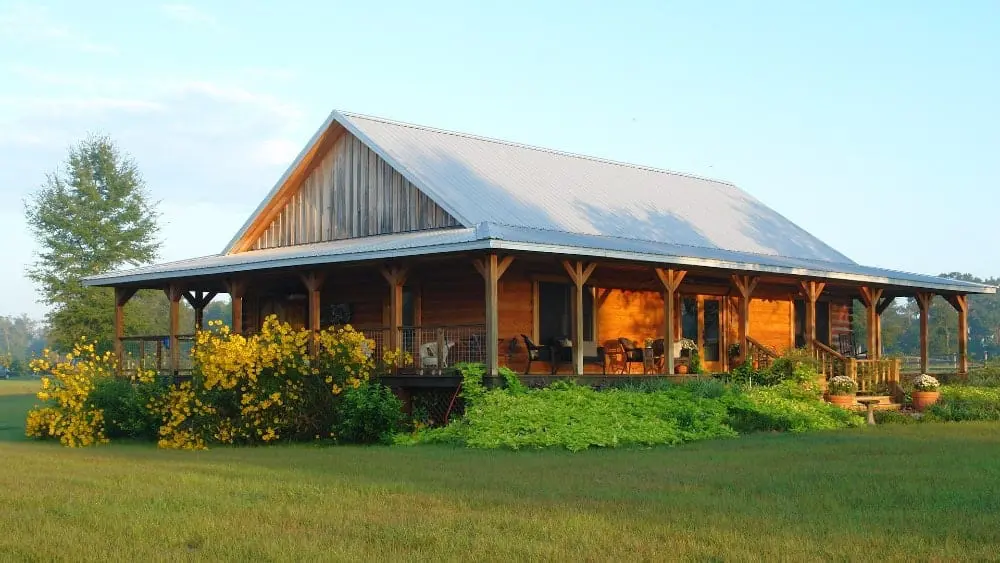
Spacious farmhouses and centuries-old homes tucked away in the remotest parts of the countryside — this is what typically comes to mind when you think of living in rural America. While life outside of the city has its charms, having an energy-efficient home can be a challenge.
Beyond the home itself, rural homeowners often face a challenge when it comes to their utilities. Because where they live isn’t as densely populated, the cost of delivering energy is typically higher. Rural communities are more likely to be serviced by small rural co-ops or publicly owned utilities compared to large-scale utility powerhouses that serve the masses at a lower cost.
According to a 2018 report by the American Council for an Energy-Efficient Economy (ACEEE), rural homeowners spend more of their income on energy bills compared to their urban counterparts. The report, titled the High Cost of Energy in Rural America, states that the median energy burden for rural homeowners in the United States is 4.4 percent compared to 3.3 percent for metropolitan homeowners. That’s a good chunk of the monthly household budget to keep the lights on and the home heated.
Rural homes also tend to be older compared to urban and suburban homes. Drafty rooms, older appliances and poor insulation play a big part of why rural homes are energy guzzlers. But rural homeowners can make changes — big and small — to their homes to make them more energy efficient. Ultimately, energy-efficient upgrades could save rural households more than $400 per year, or a 25 percent reduction of their energy burden, according to the ACEEE.
Here’s a look at eight key ways to make your rural home more energy efficient.
1. Go for the Quick Wins
If you’re cash-strapped or want to take on some DIY work before making any major changes, here are some smaller, more affordable changes you can make that will improve the energy efficiency in your home:
Change your light bulbs. Simply swapping the incandescent lighting in your home to LEDs (light emitting diodes) or CFLs (compact fluorescent lamps) can increase your home’s lighting efficiency by about 85 percent alone, according to government estimates. Lighting accounts for about 10 percent of your electric bill — invest in swapping your light bulbs and you could soon see a dent in your bills. Installing sensors, dimmers or timers could also cut your lighting use.
Adjust the thermostat. Heating and cooling your home can get pretty costly. Try keeping your thermostat lower in the winter and higher in the summer, especially when no one is home. You can rely on the sun in the daytime to help with heating and lighting your home too. Swapping to programmable thermostats and power strips can also help manage energy consumption.
Cut back on water usage. Take shorter showers a few times a week and get into the habit of running the washing machine with cold water. Checking for leaks can help you save water too.
Invest in strategic furnishings. A thick pair of curtains and heavy rugs can help trap heat in your home while keeping you warm. If you’re cold in the winter and trying to cut down on heating bills, try adding on an extra layer of clothing first before turning up the thermostat.
2. Stay on Top of Cleaning
Energy waste in older rural homes is usually tied to overdue maintenance. Get into the habit of clearing out your gutters and drains — both of which can make the walls and roof damp and cold.
Clean your air filters and air ducts at least once a year to make sure clean air is circulating around the home. A sure-fire way to check is by pulling up a vent cover and looking inside for buildup or dust, dirt, pet hair and debris. Pull out the air filter, and if it’s clogged with dust, that’s a telltale sign that airflow is blocked.
3. Add Insulation and Seal Air Leaks
Good insulation ensures your heated or cooled air isn’t seeping out of your home. How well your home is insulated is usually dictated by what the recommended guidelines were at the time, so insulation in older homes often isn’t up to current standards.
According to the UK Center for Sustainable Energy, 25 percent of heat is typically lost through the roof, 35 percent through the walls, 15 percent through the floor and 25 percent from windows and doors.
Start with plugging air leaks. Check for air leaks around the home, especially in the attic, basement and crawl space, and then seal with new caulk. This could save you more than 20 percent on heating per year. You can install weather stripping to seal air leaks around doors and windows. After this step, you may notice right away that it doesn’t take as long to heat and cool the rooms in your home.
Check the insulation in the walls of the main floors of your home. As a safety precaution, turn off the circuit breaker or unscrew the fuse for any outlets in the wall. When you’re sure the outlets aren’t getting any electricity, you’ll need to probe into the wall by removing the cover plate from one of the outlets. A plastic crochet hook, for example, could be inserted and you’ll see if it comes back with any bits of insulation material. Ideally, you’ll hit some friction so you know right away that your walls have some padding to them.
4. Update Your Appliances
The appliances used throughout your home account for 20 percent of your home’s total electricity bill. Check their age and health and save for replacements where needed. Otherwise you could be burning through energy because your appliances are on their last legs.
These days, new homes are fitted with Energy Star appliances, which are government certified as energy efficient. They use anywhere from 10 percent to 50 percent less energy per year compared to non-energy-efficient appliances.
An older dryer, for example, uses as much energy per year as new Energy Star-labeled refrigerators, washing machines and dishwashers combined. Modern dryers use 20 percent less electricity, saving consumers $210 in electric bills over the appliance’s lifetime, according to the National Resources Defense Council. So when you’re shopping for new appliances, look for Energy Star ones; the labels usually state how much you could save each month.
5. Install Heat Pumps
Geothermal heat pumps, which have been around since the late 1940s, are one of the most efficient ways to heat and cool rural homes and supply them with hot water. They use the constant temperature of the earth as a ground heat exchanger instead of relying on outside air temperature. Because they take advantage of the free heat in the earth, homeowners end up saving on their monthly utility bills.
There are approximately 50,000 geothermal heat pumps installed across the country each year. They can be pretty costly to install, unless they’re fitted to a new home. Most LEED-certified homes have a geothermal heat pump.
6. Install a Solar Panel System
If rural homeowners want to go the extra mile on energy efficiency, solar panels are another great source of renewable energy, especially if you’re interested in having a passive house. When you go solar, you can generate your own clean electricity and lock in stable electricity rates for decades.
Solar panels don’t come cheap but their prices have fallen by more than 70 percent over the last decade as they’ve become more mainstream. In 2008, they averaged $8 per watt produced but now the average cost is about $3.14 per watt.
Rural homes have space on their side, which is a huge advantage when it comes to planning a solar system or installing heat pumps. About 100 square feet of solar panels are required to produce a kilowatt of electricity. Residential homes usually produce about five to 10 kilowatts.
7. Update Your Manufactured Home
More commonly known as mobile homes, manufactured homes are built in a factory, transported and then installed on-site. They tend to be less energy efficient, especially if they’re older, and they’re more expensive to repair.
They’re also more prevalent in rural America — 20 percent of all rural households live in mobile homes. ACEEE estimates that residents of rural mobile homes spend 70 percent more per square foot on energy.
Energy-efficient adjustments specific to mobile homes include:
- Adding insulation to the belly and installing a belly wrap
- Adding insulation to the walls
- Installing insulated skirting
- Adding insulation to the roof or installing a roof cap
Pilot tests conducted on decades-old manufactured homes by the National Renewable Energy Laboratory found that these renovations led to a 31 percent reduction in heating usage.
8. Take Advantage of Government Programs
Rural homeowners are more likely to be low-income earners with an increased risk of having their utilities shut off. In some cases, the ACEEE suggests homeowners could be deciding between heating the home or keeping the lights on, leaving them unable to make energy-efficient upgrades. However, government-funded programs that provide tax breaks, rebates and other incentives can help rural homeowners shoulder the cost.
For example, homeowners upgrading to Energy Star appliances or investing in solar panels have a number of U.S. Department of Energy and state rebates to sign up for. In some cases, depending on where you live, state programs reimburse households by up to 50 percent.
Look into whether your municipality has a rebate program for recycling your old appliances too. Massachusetts has a longstanding Mass Save program that provides homeowners with a $200 rebate for buying an energy-efficient refrigerator and another $50 for recycling their old one. Other Mass Save rebates apply for swapping to LED lights, using advanced power strips or installing a heat pump.
There’s also the Department of Energy’s Weatherization Assistance Program, which helps low-income households retrofit their homes to cut their energy costs. The program helps 35,000 homes each year, and with the proper repairs and upgrades, households can end up saving $283 or more each year.

Carmen Chai is an award-winning Canadian journalist who has lived and reported from major cities such as Vancouver, Toronto, London and Paris. For NewHomeSource, Carmen covers a variety of topics, including insurance, mortgages, and more.
 How to Annoy Your HOA
How to Annoy Your HOA